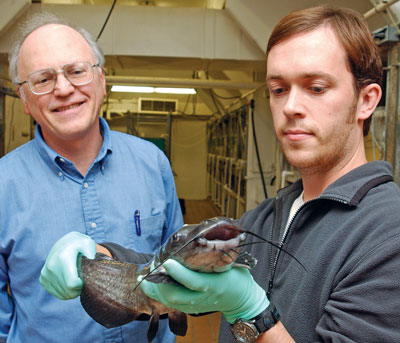
In an average work day, most people do not think about the disappearance of frogs and salamanders, but it’s an everyday challenge for Dr. Greg Chinchar.
Chinchar, professor of microbiology at the UM Medical Center, is collaborating with scientists from around the world to study the disappearance of frogs and salamanders, referred to as amphibian decline. It’s all part of his work using several types of aquatic animals to explore viral immunology.
As they have researched the vexing decline of amphibian species, Chinchar and his colleagues have concluded that the transportation and sale of live bait is the latest example of a human activity that may be responsible for spreading diseases with dramatic ecological consequences. According to Chinchar, genetic analysis of an emerging virus called Ambystoma tigrinum virus, or ATV, indicates that the virus may have been transmitted to remote locations through the sale of live bait. ATV has been implicated as a cause of local die offs of salamanders in the western United States.
Salamanders, sold as “waterdogs,” are a popular live bait in Arizona and throughout the region. ATV-infected salamanders are being widely distributed and, as a consequence, the virus is being introduced into uncontaminated environments by fishermen.
Chinchar—along with Arizona State University ecologist James Collins, who is serving a two-year term as assistant director of biological sciences at the National Science Foundation, and a number of other investigators—found that ATV isolates from Arizona and Colorado are all genetically very similar, suggesting a recently emerged or introduced strain. The strain closely matches viruses isolated from salamanders found in bait shops, indicating a possible source for the pathogen’s introduction.
Chinchar compares the team’s work on ATV with the three stages of medicine described by Lewis Thomas in his book The Youngest Science.
“Before 1800, there was little a doctor could do other than console his patient,” Chinchar says. “In the 19th century, a good doctor could diagnose the illness but didn’t have the tools to cure the patient. It was not until the mid-20th century, with the advent of antibiotics and new surgical techniques, that physicians were able to treat and/or cure multiple physical problems.

“I think we are in the middle stage in terms of amphibian decline and infectious disease. We have identified two principal infectious agents of amphibian death (ranaviruses such as ATV and chytrid fungi) and have a handle on how [they] are transmitted. However, the $64,000 question is, ‘Can we do something to prevent these infections?’”
This is not Chinchar’s first foray into the biology of swimming creatures. More than 20 years ago, he joined the Medical Center faculty to work with Dr. Bill Clem, then chairman of microbiology, and Dr. Norman W. Miller, professor of microbiology, in developing pond-raised catfish as a model to study the immune system. Clem was one of the first scientists to recognize and characterize the immune systems of lower vertebrates. Using animals as diverse as sharks, alligators, fish and chickens, he changed the way scientists approached the immune system of lower vertebrates.
“When Dr. Clem came here in the late 1970s, he had been working with sharks at the University of Florida,” Chinchar says. “But he realized that sharks might be scarce in middle Mississippi. He switched to catfish, the state’s most commercially and agriculturally important fish.”
Because of the work in the Medical Center’s microbiology department, the catfish is recognized as the best model system for studying immune function in fish and is responsible for much of what is known about fish immune systems, he says.
“Drs. Clem and Miller found that you could readily establish long-term white blood cell lines from catfish that allow researchers to examine immune responses in a more defined in vitro environment.”
Chinchar is primarily interested in antiviral responses. He says he is trying to understand antiviral immune response in lower vertebrates with the idea that this might not only protect fish against viral infections but also elucidate key aspects of antiviral immunity in mammals, including humans.
“At a more practical level, if you could figure out a way to protect catfish against infectious disease, it would have a major impact on the industry, because about a quarter of the fish are lost each year to infections,” Chinchar says. “If one could block or inhibit infections, perhaps by enhancing the catfish immune response, it will help the economy of Mississippi.”
Chinchar says his research points to the importance of collaborative research because it involves studies here and at Vanderbilt University, Arizona State and the University of Rochester.
One example of the power of these collaborative efforts to span disciplines surfaced recently. As part of his work on infectious causes of amphibian decline, Chinchar teamed with Dr. Louise Rollins-Smith, associate professor of microbiology and immunology at Vanderbilt Medical Center, to examine the ability of various amphibian-derived antimicrobial peptides, or AMPs, to inactivate two physiologically important viral pathogens of lower vertebrates, channel catfish herpesvirus and frog virus 3. They found that both viruses were readily inactivated by various amphibian AMPs.
Rollins-Smith, working with investigators at Vanderbilt, built on these results and decided to study whether amphibian AMPs also inactivate HIV-1. Their work, detailed last fall in the Journal of Virology, showed that amphibian AMPs effectively inactivated HIV-1 and blocked the transfer of HIV-1 from dendritic cells to T cells. This suggests that amphibian AMPs may show promise clinically as topical inhibitors of vaginal HIV transmission.
While work on amphibian AMPs continues at Vanderbilt, Chinchar and his co-workers at the UM Medical Center intend to pursue two complementary, but independent, avenues of research. First, he plans to work with the Medical Center’s catfish group to elucidate key elements of antiviral immunity in catfish, such as natural killer cells, cytotoxic T cells and interferon. These studies will advance understanding of the immune systems of lower vertebrates and have the potential to better protect fish from infectious diseases.
Second, he is working closely with colleagues at Arizona State University and elsewhere to understand the function of genes controlling virus replication, host range and immune evasion. Study of replicative genes will advance understanding of the life cycle of an emerging viral pathogen of fish and amphibians, whereas study of host range and immune evasion genes will shed light on the myriad ways viruses have devised to avoid host immunity and spread from animal to animal. One of the immune-evasion genes under study is similar to a protein found in various poxviruses—including smallpox—suggesting that fundamental mechanisms uncovered in a model system seemingly remote from humans and their diseases may provide important insights that may positively impact human health.
Perhaps John Steinbeck said it best in his novel Cannery Row. “Sic semper cum frogs”—or “thus always with frogs”—also applies to frog viruses and their relatives as they provide insight into not only their own biology but also that of humans and their diseases.